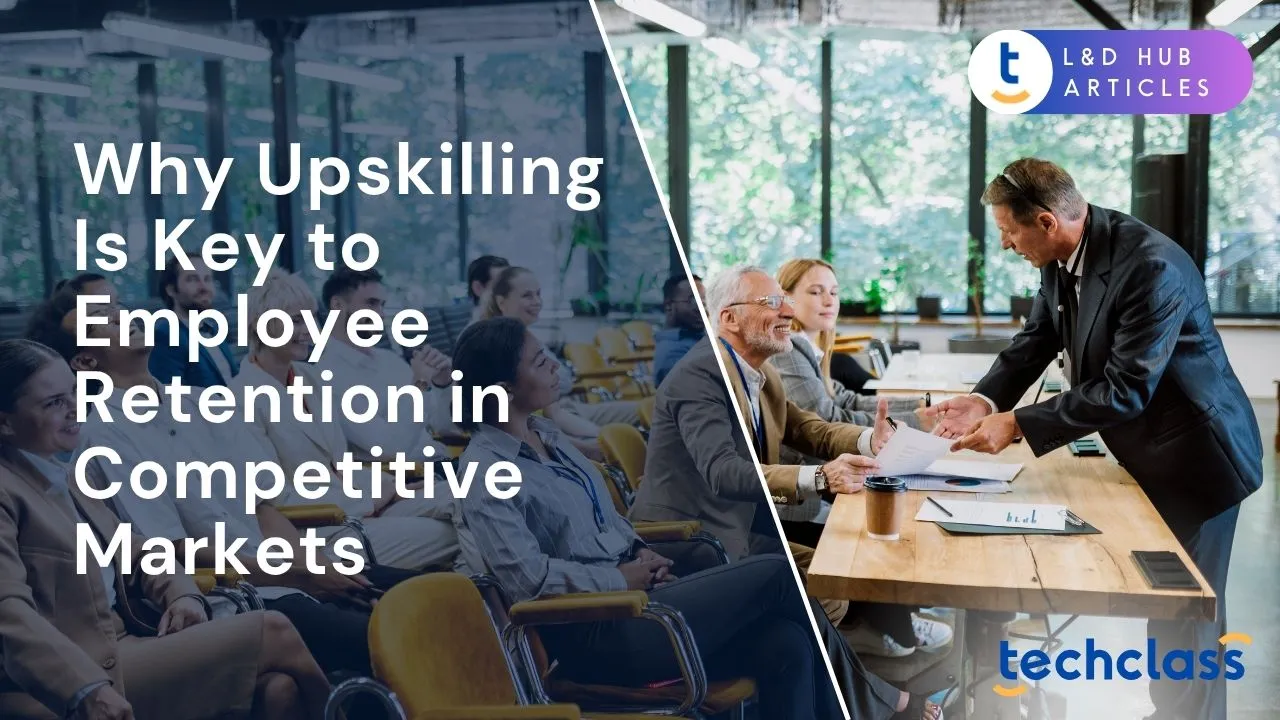
In today’s ultra-competitive job market, employees have more opportunities than ever to jump ship for better roles. Nearly 9 in 10 companies are actively hiring, making the competition for skilled talent fierce. High turnover is costly and disruptive, replacing a single employee can cost anywhere from half to twice that employee’s annual salary when you factor in recruiting and training expenses. Faced with these pressures, business leaders and HR professionals are searching for effective strategies to boost employee retention. One proven strategy is to invest in your people’s growth through upskilling. Upskilling means providing existing employees with training and development to learn new skills or expand their capabilities. It has emerged as a powerful way to keep employees engaged, motivated, and committed to your organization for the long term. In this article, we’ll explore why upskilling is so critical for retaining talent in competitive markets and how companies can implement upskilling programs to improve retention. We’ll also look at real-world examples and research that demonstrate the impact of upskilling on employee loyalty and business success.
Upskilling refers to teaching employees new skills or enhancing their existing skills, enabling them to perform new tasks or take on higher-level roles. It is different from reskilling (which prepares employees for a different job function), upskilling typically focuses on growth within an employee’s current career path. For example, a marketing specialist might learn data analytics, or a customer support rep might train in people management to become a team leader. In the context of retention, upskilling is about investing in employees’ career development so they can advance without leaving the company.
Why is this so important today? Simply put, a lack of growth opportunities is driving people to quit. For over a decade, “lack of career development” has been the number one reason employees leave their jobs. A comprehensive retention report showed that year after year, employees cite limited learning and advancement potential as their top motivation for seeking a new job. This trend holds true across ages and industries, humans have an innate desire to learn and progress, and if they feel stuck, they will look elsewhere. In a competitive market flush with job openings, talented people won’t hesitate to move on if they don’t see a future at their current company.
At the same time, rapid technological change is making upskilling a business imperative. The skills required in many roles are evolving fast, one analysis found that 44% of workers’ skills will be disrupted in the next five years, and six in ten employees will need upskilling or reskilling by 2027. Automation and digital transformation mean companies must continuously retrain staff to keep up with new tools and processes. Without ongoing development, employees’ skills can quickly become outdated, leaving both the worker and the employer at a disadvantage. Upskilling addresses this by future-proofing your workforce. It ensures employees stay competent in their roles as the industry changes, which in turn helps the company remain competitive. Organizations recognizing this trend are making significant investments in employee learning. For example, several large enterprises have launched ambitious upskilling initiatives: JPMorgan Chase put $600 million toward upskilling programs, Amazon committed $700 million to retrain 100,000 employees, and PwC is spending $3 billion to upskill all 275,000 of its staff over a few years. These companies see upskilling not only as a way to fill skill gaps but also as a strategy to retain their talent by offering continuous growth. In essence, upskilling has become a key part of the employee value proposition, it shows your people that you are invested in their future.
Understanding why employees quit is the first step in crafting any retention strategy. Research consistently shows that lack of development is at the heart of the issue. In a recent study, 22% of employees who left their jobs did so due to having no clear career path at their organization; this was the single biggest reason for quitting, higher than factors like pay or workload. Similarly, in a McKinsey survey during the “Great Resignation,” 41% of people who quit cited lack of opportunities for advancement as a primary reason for leaving. These numbers underscore that many resignations are preventable – employees are not necessarily eager to job-hop; they are seeking growth. If they can’t grow with you, they will grow elsewhere.
Upskilling directly addresses this retention problem by fulfilling employees’ need for progress. By providing training and educational opportunities, companies give employees a tangible career development path. They no longer feel stuck in a dead-end role because they see the company investing in expanding their skills and preparing them for bigger responsibilities. Consider this striking data point: 94% of employees say they would stay at a company longer if it invested in their career development. This finding from LinkedIn’s Workplace Learning Report highlights just how closely development opportunities tie into the decision to stay or go. When employees feel their employer is helping them grow, they develop loyalty and are far less likely to leave. On the flip side, employees who feel underutilized or stagnant are much more prone to disengage. In fact, one analysis found that workers who feel their skills are not being put to good use are 10 times more likely to be looking for a new job. Upskilling can prevent that scenario by continually challenging employees with new learning and stretching assignments.
It’s also worth noting that upskilling has become particularly important for younger generations in the workforce. Millennial and Gen Z employees rank learning and growth as top priorities in their careers. One study found that 74% of Millennials and Gen Z would consider quitting a job if it lacked opportunities to upskill and develop. Unlike past generations who might have stayed in one role out of loyalty or job security, today’s early-career professionals won’t hesitate to leave if they feel their growth is stagnating. They actively seek out employers known for training and development. In a recent survey, 70% of employees – and an even higher percentage of high-potential younger employees – said they would leave their current job to join an organization famous for investing in employee development. This means companies that neglect upskilling not only risk losing their current staff, but also may struggle to attract new talent. On the other hand, building a reputation for strong learning and development can become a magnet for driven candidates and help retain the ambitious employees you already have.
In short, people leave when they feel they have stopped learning. Upskilling flips that script by creating an environment where learning never stops. It addresses the root causes of voluntary turnover, lack of growth, feeling undervalued, and skill stagnation, by continuously feeding employees’ appetite for knowledge and showing them a path forward in the organization. When employees see that path, they have a compelling reason to stay.
Upskilling doesn’t just keep employees happy in the abstract – it produces concrete benefits that improve retention and boost organizational performance. Let’s explore some of the key benefits for both employees and employers:
In summary, upskilling creates a more engaged, adaptable, and loyal workforce. Employees gain new capabilities and career momentum; employers gain higher retention, productivity, and a stronger talent pipeline. It transforms retention from a reactive effort (trying to persuade someone to stay after they’ve decided to leave) into a proactive strategy (continually giving people reasons to stay). By building employees’ skills, you build their commitment to your organization.
Knowing the benefits of upskilling is one thing – implementing it effectively is another. To truly make upskilling a retention driver, companies should integrate learning into the fabric of their culture. Below are some strategies and best practices for creating a continuous learning culture that keeps employees growing and engaged:
By following these strategies, organizations can cultivate a continuous learning environment where upskilling is ingrained in day-to-day operations. Remember that building such a culture is an ongoing effort, not a one-time program. Solicit feedback on your upskilling initiatives and be willing to iterate. The goal is to make learning part of your identity in the workplace. When employees feel that development is woven into their experience at the company, they are far more likely to commit their future to it. As one HR adage goes, “people join companies, but they leave managers” – and a manager who coaches and develops their people will find those people tend to stay.
In competitive markets where employees have ample options, companies must differentiate themselves by how they treat and grow their talent. Compensation and perks are important, but as we’ve seen, career growth is often the deciding factor in whether your best people stay or go. Upskilling has emerged as a key to employee retention because it aligns the company’s success with the employee’s success. By developing your employees’ skills, you create a pathway for them to advance without leaving, increase their engagement, and demonstrate that you value their contributions and future potential. This not only curbs turnover but also builds a more capable and agile organization. The employers who embrace upskilling are effectively saying to their workforce, “Your growth is our priority” – and that message is rewarded with loyalty.
On the other hand, failing to provide growth opportunities is risky in the current climate. Employees who feel their development is neglected are not likely to stick around. No organization wants to become a “talent factory” that trains people only to see them leave for competitors. Investing in upskilling helps ensure that the investment you make in hiring and onboarding employees pays off over the long haul, as those employees contribute more value over time. It also boosts morale and attracts new talent, creating a positive cycle of continuous improvement.
In conclusion, retaining employees in a competitive market comes down to offering something they can’t easily find elsewhere – a genuine commitment to their professional growth. Upskilling is the vehicle for that commitment. When you prioritize learning and development, you transform your workplace into a place of opportunity. Employees who see opportunity are inspired to stay and give their best. In an era of rapid change and talent shortages, investing in your employees’ skills is investing in the future of your business. Companies that make upskilling a core strategy will not only retain their top performers but also unlock higher performance and innovation. It’s clear that in the race for talent, those who grow their own people from within will have the ultimate competitive advantage.
Upskilling keeps employees engaged, motivated, and helps them see a clear growth path, reducing their likelihood of leaving.
It provides career development opportunities, fulfilling employees’ need for progress and preventing feelings of stagnation.
It increases engagement, loyalty, internal mobility, reduces costs, boosts productivity, and encourages innovation.
Assess skill gaps, offer diverse learning opportunities, integrate development into career paths, and lead by example.
Millennials and Gen Z seek growth opportunities; they are more likely to leave jobs that lack development chances.
.webp)
.webp)
